Silk Road Travelogue by Ali Karim: (5) Ismailis of Remote Northern Hunza Rise High Above the Tallest Peaks, and Set a Lasting Example for Us to Follow

Ali Karim and his wife Dilshad at the banks of the Hunza river with the stunning Cathedral Peaks in the background. The foot of the mountains at the right is etched with the words “Welcome to Pasu Our Beloved Hazar Imam 1987.” Photo: © Ali Karim.
In the first four parts of my Silk Road travelogue, I covered my journey that I undertook with my wife, Dilshad, to Urumqi, Turpan, Kashgar and Tashkurgan in the autonomous Xinjiang province of China. My pieces may be read by clicking on the following links:
- Silk Road Travelogue By Ali Karim: (4) Scenes from Tashkurgan and an Encounter with an Ismaili Family, and the Drive to Northern Hunza on the Iconic Khunjerab Pass
- Silk Road Travelogue by Ali Karim: (3) More Kashgar and Spectacular Drive to Tashkurgan
- Silk Road Travelogue by Ali Karim: (2) More of Turpan and Historic Kashgar
- Silk Road Travelogue by Ali Karim: (1) Shanghai, Urumqi and Turpan

Part 4 of the Silk Road travelogue covered Ali and Dishad Karim’s stay in Tashkurgan and their bus ride to the China-Pakistan border at Khunjerab pass on the Karakoram Highway. In this Part 5, Ali describes the trip from Khunjerab Pass to Sost and their incredible stay in Khyber Village (not shown) and Passu.
Now with this 5th part, I commence the Northern Pakistan phase of our trip! I must state at the beginning, and without any reservation whatsoever, that the disappointment Dilshad and I felt at not being able to meet a larger segment of the Ismaili jamat in Tashkurgan due to our curtailed visit, was offset by the most beautiful memories that we came away with in meeting the Ismailis of Hunza! The trip to Hunza was exhilarating and inspiring for many reasons. We were immensely touched by the warmth and beauty of Hunza’s people who are surrounded by the most daunting and stunning of all the mountain peaks on this earth; their accomplishments in numerous areas of human endeavour – from education and high literacy levels to socio-economic development and good health – left us both breathless and speechless! We never imagined for one moment that we would come across people living in one of the remotest parts of the world who would speak good English, and that they would accept total strangers like us into their homes uninvited, through a sheer knock on their door! We were made to feel part of their own families! I am delighted that you are now on this page to experience just a little bit of what we came across in this heavenly and beautiful region of this earth, which is inhabited by Ismailis, followers of His Highness the Aga Khan!
Khunjerab Pass to Sost
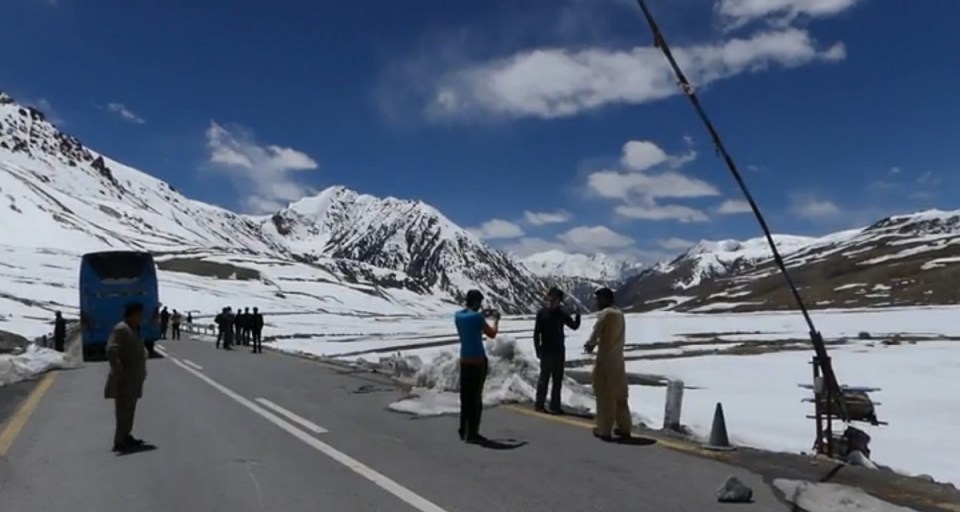 A few metres into Pakistan at Khunjerab Pass on the famous Karakoram Highway. Photo: Ali Karim.
A few metres into Pakistan at Khunjerab Pass on the famous Karakoram Highway. Photo: Ali Karim.
We travelled from Tashkurgan, the last town in China on the Karakoram Highway (KKH), and crossed the border into Hunza in Northern Pakistan at the iconic Khunjerab Pass, the highest paved border crossing in the world on the KKH.
Hunza, is a mostly Ismaili district of Gilgit-Baltistan Province. It was all originally part of Kashmir before partition, but in the wars after independence, this part of Kashimir came under Pakistan control. Until 1974, Hunza was actually a princely state headed by the Mir of Hunza. The Kingdom was dissolved by Pakistan’s then Prime Minister Zulfikar Ali Bhutto. Many Ismailis would remember the Mir by the pearls that his wife showered on Mawlana Hazar Imam and Begum Salimah when they got married in 1969.
The Pakistani border post is at Sost; which is about 75kms from the China-Pakistan border at Khunjerab Pass. So while we were physically in Pakistan, we were not officially in Pakistan since we had not been processed by Pakistani immigration. So we stayed on the bus, while travelling along the KKH in Hunza. We saw lots of rock and glacier slides over the highway and noted that the Pakistani side of the KKH was not as well taken care of as the KKH on the Chinese side, where it had been immaculately maintained.
The scenery along our drive was spectacular; with the huge snow capped mountains of the Karakoram range all around us, and the Hunza glacial river running in the valley where the KKH made its way south.

The mighty Karakoram Highway snaking along the valley in upper Hunza. The famous highway starts in Kashgar in Xinjiang, China, and runs 1300 kms to Abbottabad in Pakistan before an extension of the highway southwest from Abbottabad, in the form of the N-35 highway, meets the Grand Trunk Road, N-5, at Hasan Abdal, which is about 40 kms from Rawalpindi. Photo: © Ali Karim.
 Wonderful rock formations along the Hunza River. Photo: © Ali Karim.
Wonderful rock formations along the Hunza River. Photo: © Ali Karim.

An amazing photo of a glacier that has avalanched over the Hunza River. The glacier has turned dark by picking up dirt and rocks. Photo: © Ali Karim.
At one point, we were forced to stop completely as the road was closed off because of a rock slide further up the road. We were informed it would take about 30-40mins to clear the road. So we waited and stretched our legs. Suddenly, there was a very loud explosion and I panicked as I thought that might be another rock slide near us. However, it turned out that this was a controlled blast of the rocks on the rock slide ahead to allow the earth mover to clear the KKH.
 Leg-stretching time as a rock slide ahead of the truck on KKH closes the road for about 30-40 minutes: Photo: © Ali Karim.
Leg-stretching time as a rock slide ahead of the truck on KKH closes the road for about 30-40 minutes: Photo: © Ali Karim.
 A tractor clears rocks on the road after a controlled blast. Note the steep hillsides with plenty more potential rock slides in the making. Photo: © Ali Karim.
A tractor clears rocks on the road after a controlled blast. Note the steep hillsides with plenty more potential rock slides in the making. Photo: © Ali Karim.
 Spectacular scenery of the Karakoram mountain range along the KKH in Upper Hunza. Photo: © Ali Karim.
Spectacular scenery of the Karakoram mountain range along the KKH in Upper Hunza. Photo: © Ali Karim. 
Massive boulders tower over a ‘miniature’ SUV travelling on the Karakoram Highway. Photo: © Ali Karim.
Upon our arrival st Sost, the official Pakistani border post, we were met by our Ismaili driver, Zafar. After clearing Pakistani customs/immigration, we left the bus and made our way in his car to Passu village. We were now in the Upper Hunza valley. There were multiple small villages — Hussainabad, Nazimabad, Jamalabad, Khyber and more — along the Hunza River valley where flat land was either available or terraced to allow growing of crops including potatoes, corn, wheat, aubergine, long beans as well as fruits like apples, apricots and almonds. Everyone in this region is an Ismaili and we spent some time here to meet the locals, visit their homes and jamatkhanas that are present in every village.
The Jamatkhana at Khyber Village

Happy Ismailis at the Khyber village in Northern Hunza. Photo: © Ali Karim.
 A view of the Khyber village, home to Ismaili families in Northern Hunza. Photo: © Ali Karim.
A view of the Khyber village, home to Ismaili families in Northern Hunza. Photo: © Ali Karim.  The local jamatkhana in Khyber village is nested on top of a hill, and is surrounded by some of the highest mountains in the world. There is an archway entrance at the foot of the hill beyond which several stairs lead upto to the jamatkhana building. Photo:© Ali Karim.
The local jamatkhana in Khyber village is nested on top of a hill, and is surrounded by some of the highest mountains in the world. There is an archway entrance at the foot of the hill beyond which several stairs lead upto to the jamatkhana building. Photo:© Ali Karim.
 A close-up of the Khyber village jamatkhana. Photo: © Ali Karim.
A close-up of the Khyber village jamatkhana. Photo: © Ali Karim.
 An interior view of the Khyber village jamatkhana. Photo: © Ali Karim.
An interior view of the Khyber village jamatkhana. Photo: © Ali Karim.
 Dilshad (front centre) is photographed with Ismaili youth of Khyber village who gave her and Ali a tour of the jamatkhana. Photo: © Ali Karim.
Dilshad (front centre) is photographed with Ismaili youth of Khyber village who gave her and Ali a tour of the jamatkhana. Photo: © Ali Karim.
The whole Upper Hunza valley has simply spectacular views. We have never experienced such natural beauty anywhere before. Pictures simply cannot do justice to this spectacular landscape.
Heavenly Passu

Writing etched into the mountainside in Passu commemorating Mawlana Hazar Imam’s visit in November 1987. The cathedral peaks are at the left. Photo: © Ali Karim.
After a few hours at the Khyber village we travelled approximately 25 kms to Passu. When we entered Passu, we saw the greeting etched on the mountain-side across the Hunza river commemorating His Highness the Aga Khan’s visit there in November, 1987.
 A close up view of the writing on the mountain. Photo: © Ali Karim.
A close up view of the writing on the mountain. Photo: © Ali Karim.
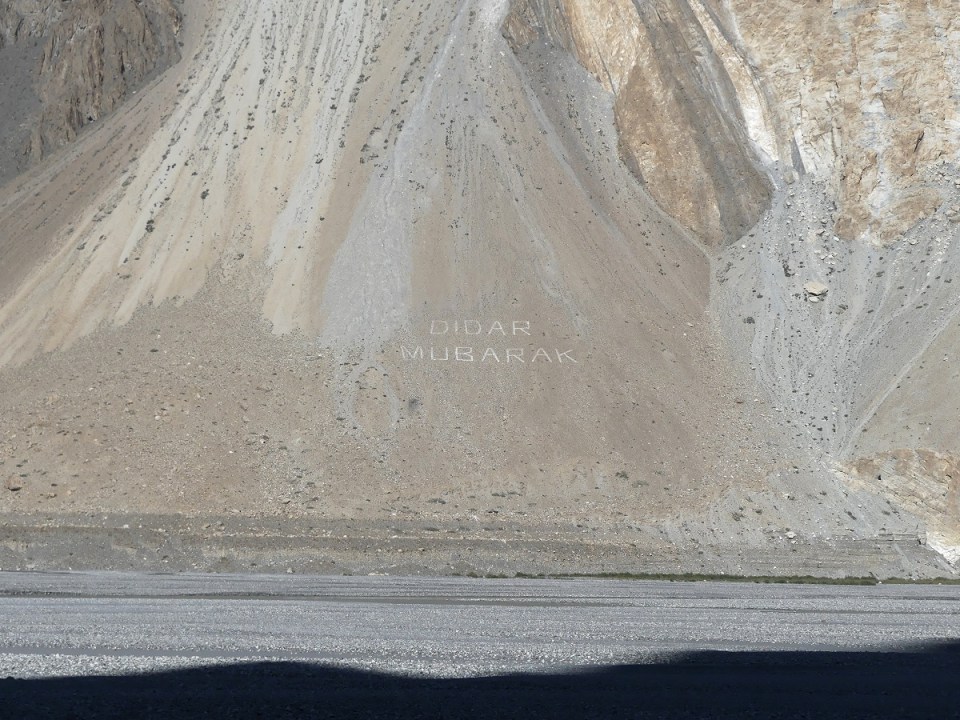
Another etching on the mountain slopes extending congratulations to Ismailis on the occasion of Mawlana Hazar Imam’s didar (lit. glimpse). Photo: © Ali Karim.
We stayed at the Sarai Silk Lodge in Passu; a basic hotel with spectacular views. Passu had no internet, and cellular service was provided by a very local carrier, with no agreements with US carriers, so we had no cellphone service either. We were disconnected from the outside world for a couple of days but this was fine!

The stunning Cathedral Peaks pictured during daytime behind Sarai Silk Lodge, where Ali and Dilshad stayed in Passu. Photo: © Ali Karim.
 Astonishing scenery from Sarai Silk Lodge! Photo: © Ali Karim.
Astonishing scenery from Sarai Silk Lodge! Photo: © Ali Karim.

A view of the lower-end or terminus of the 20.5 km Passu Glacier from the Sarai Lodge. The glacier covers an area of 115 sq km. The Passu Peak in the back of the Glacier is not visible in this photo because of clouds. Passu Peak, which rises to 7,478 m (or 24,534 ft), was first climbed by Captain Sher Khan (later Colonel) who was part of joint Pakistan-Japan army expedition in 1978. Photo: © Ali Karim.
After settling down at the lodge, Abbas came by and introduced himself as our guide for the rest of the journey. After discussing our Pakistan trip plans, and a quick dinner, we drove with him and then joined local Ismailis who were walking to their very nice, small, jamatkhana for evening prayers. The sun was still setting but it had become quite dark where we were. The huge mountain peaks all around block a lot of the setting sun’s light; and since there were no street lights around, the cellphone lights came in very handy.

A sunset view of the mountains from the Sarai Silk Lodge. Photo: © Ali Karim.
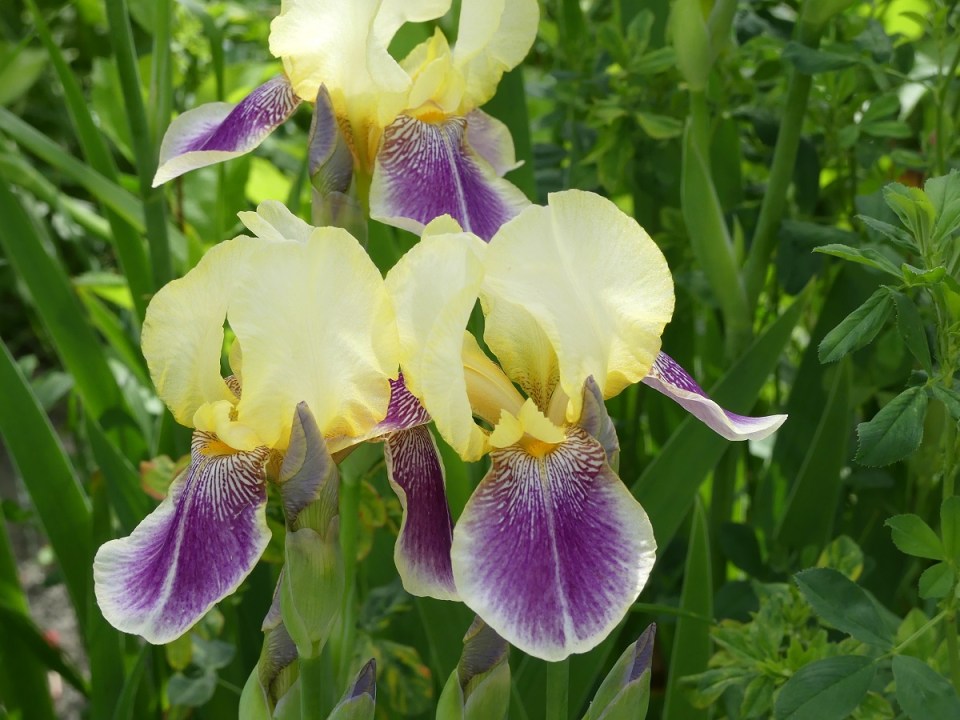
A “humble” flower adding beauty to the majestic landscape of Northern Hunza. Photo: © Ali Karim.
The Passu Jamatkhana
After the jamatkhana ceremonies, we met all the local jamati members in the jamatkhana compound and got a tour of the facility. There were about 70 people in attendance at the jamatkhana on that day. Passu is a small village, and everyone knows each other, and they knew that their Ismaili bretheren from abroad had just arrived. They almost all spoke English, as they are all 100% literate. The jamat was very hospitable and warm, and several families asked us to go to their homes, but this was not possible.

The jamatkhana premises in Passu. The Passu jamatkhana photos were captured during daytime, a day after Ali and Dilsad Karim arrived in the village. Photo: © Ali Karim.
 The main jamatkhana at Passu. Partially visible at the top centre of the brick wall is a plaque of the jamatkhana, which is shown on the next photo from a closer range. Photo: © Ali Karim.
The main jamatkhana at Passu. Partially visible at the top centre of the brick wall is a plaque of the jamatkhana, which is shown on the next photo from a closer range. Photo: © Ali Karim.
 Photo: © Ali Karim.
Photo: © Ali Karim.
 A plaque outside Passu’s jamatkhana building. Photo: © Ali Karim.
A plaque outside Passu’s jamatkhana building. Photo: © Ali Karim.
When we got back to our lodge after the jamatkhana, it was pitch dark. There were no street lights, and except for the millions of bright stars in the sky, we could not see anything around us. The night sky was simply breathtaking! It is often observed that the area around Passu is the closest thing to heaven on Earth! The pictures of the jamatkhana shown above were taken during the daytime after our visit to the Early Childhood Development Centre on the following day.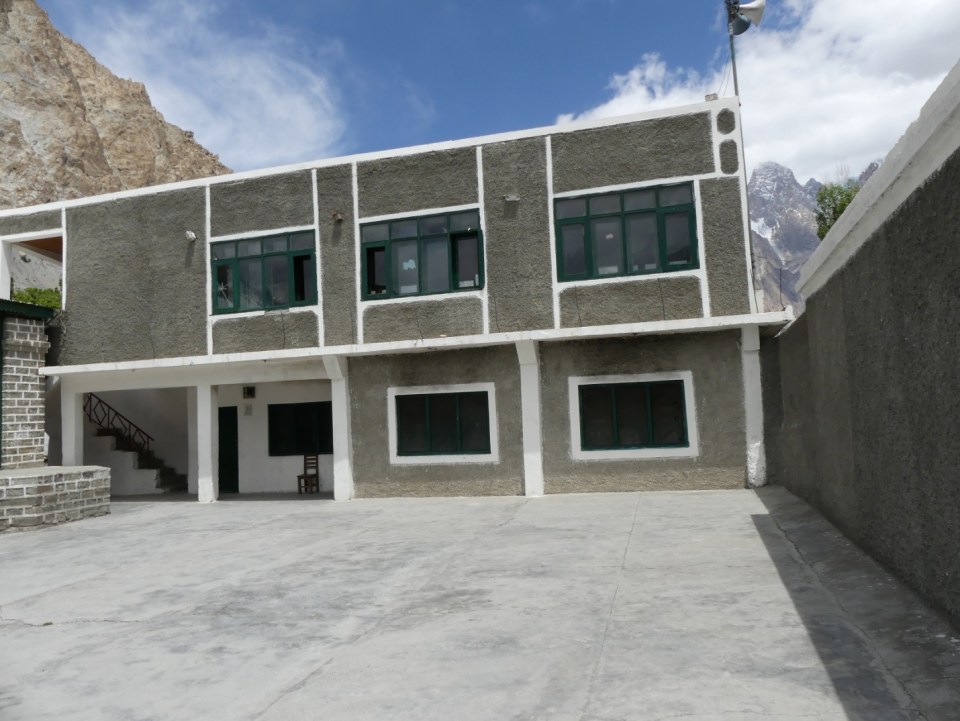
Religious education classrooms, kitchen and social hall are among the facilities provided in this building in the jamatkhana compound. Photo: © Ali Karim.
Ismaili Portraits and Ismailis at Work and School in Passu
Passu is a small village of less than 100 households, and all are farming households rearing cows, yaks, sheep and goat. The people of Passu are simple, very friendly and inviting mountain people. They are mainly located on the banks of the Hunza river which starts from a glacier at Khunjerab Pass.
The homes used to be built with stones and mud adobe, but were improved over time and now are cinder block built. Inside, the houses have the traditional design ceiling of squares inside squares, just as in the Gorno-Badakshan or Pamir region of Tajikistan. Apparently, this design is supposed to be very good for withstanding earthquakes.
As we walked through the village on the next day, we met people who invited us to tea at their homes. We were touched by their warmth and friendliness. We also noted that most of the families were out in their fields working their vegetable fields, and among them was the family of the local Ismaili Council President!
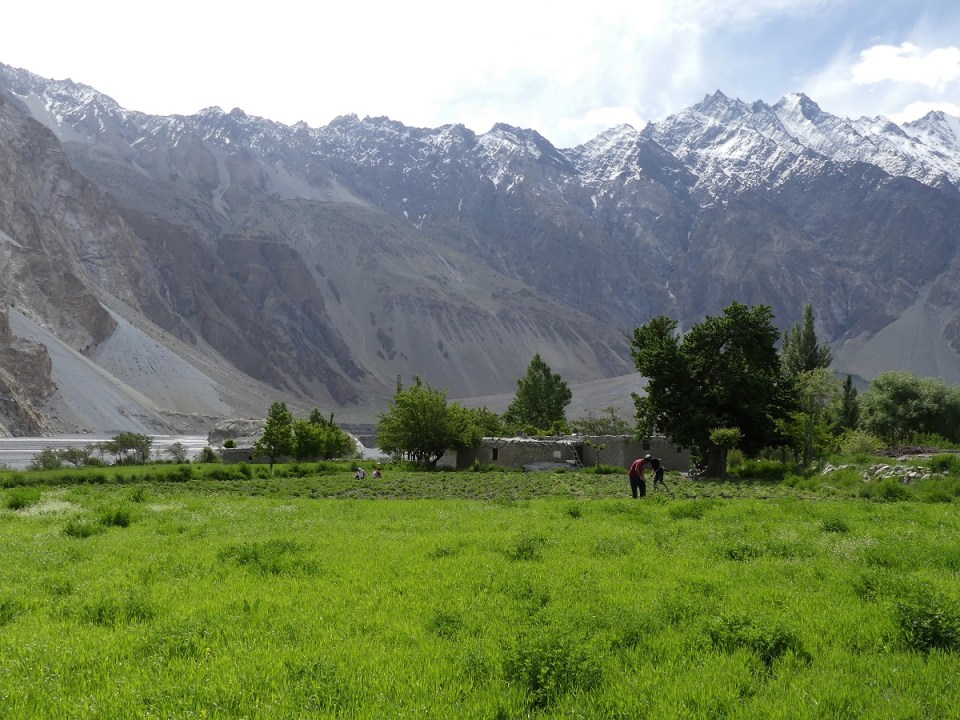
Entire families work hard in their farm fields. In this picture we see the family of local Ismaili council president (far right) and his son working on their potato field with his wife and mother who are pictured at the left side. Photo: © Ali Karim.
 An Ismaili lady hard at work in Passu village. Photo: © Ali Karim.
An Ismaili lady hard at work in Passu village. Photo: © Ali Karim.
 A young Ismaili boy is walked to his school by his grandmother. The literacy rate in this region is 100% and most people can speak in English! Photo: © Ali Karim.
A young Ismaili boy is walked to his school by his grandmother. The literacy rate in this region is 100% and most people can speak in English! Photo: © Ali Karim.
 An Ismaili farmer tends to her potato crop. The women in Passu work very hard — they take care of the house and their families, rear domestic animals and do farm work. And they are always smiling! Photo: © Ali Karim.
An Ismaili farmer tends to her potato crop. The women in Passu work very hard — they take care of the house and their families, rear domestic animals and do farm work. And they are always smiling! Photo: © Ali Karim.
 An Ismaili farmer in Passu. Photo: © Ali Karim.
An Ismaili farmer in Passu. Photo: © Ali Karim.
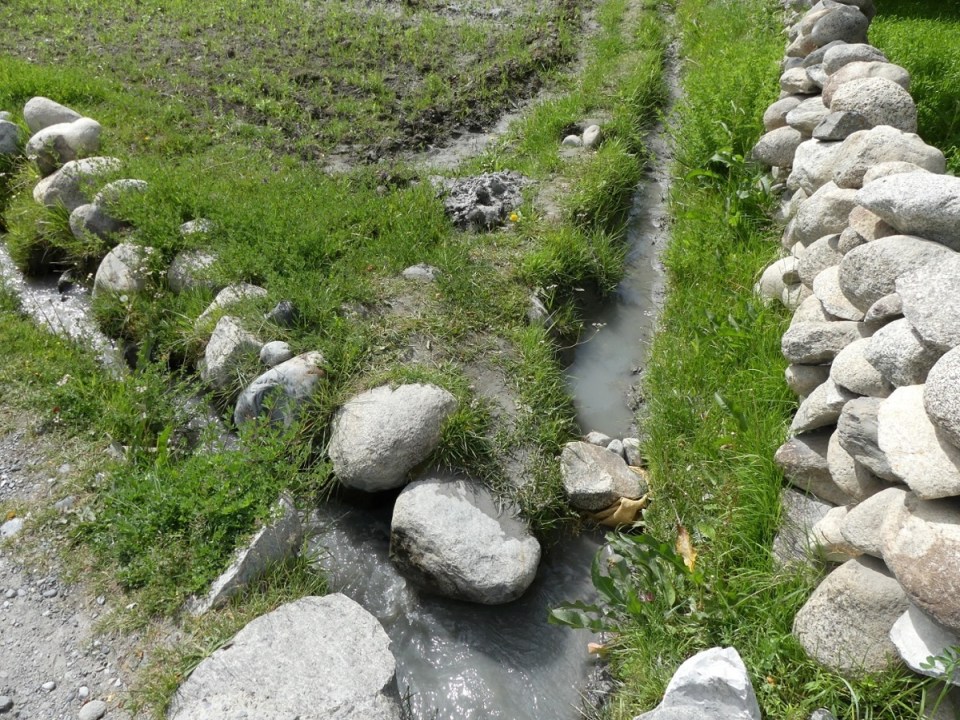
Water channels were dug by the villagers from lower down the glaciers to bring irrigation water, such as this, to all the farms, by gravity. Every small plot for growing crops was irrigated; simple but very effective. Canals for irrigation water flows are controlled by the “damming” stones. Not high tech, but it works. Photo: © Ali Karim.
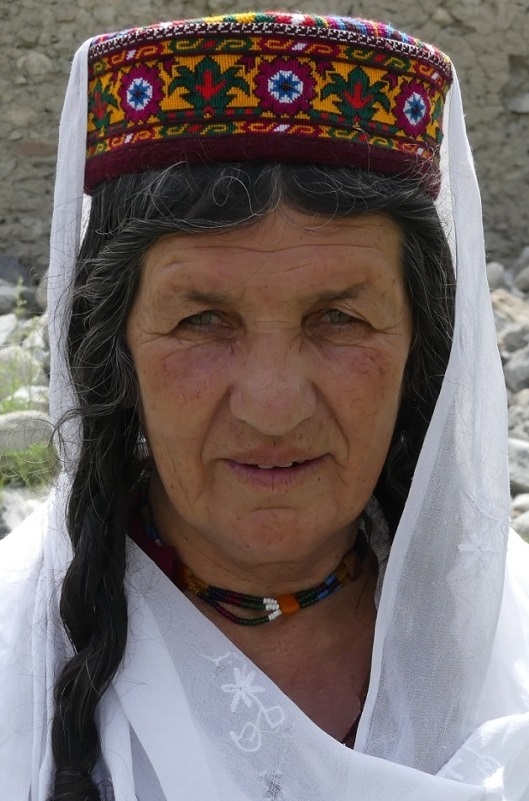 A portrait of an Ismaili lady in Passu. Photo: © Ali Karim.
A portrait of an Ismaili lady in Passu. Photo: © Ali Karim.
 Typical house (cinder block, right) and a shed for animals and food (left). The yard/farm is fenced off with river rocks. There are beautiful backdrops everywhere. All houses here have clean running water gathered from higher up the glaciers, and piped to all houses. Each home also has a septic tank, and electricity from micro and macro power stations. A lot of this basic infrastructure development was brought about by the Aga Khan Rural Support Program beginning in the 1980’s. This has significantly improved the health and well-being of families in the Hunza and Gilgit-Baltistan region. Photo: © Ali Karim.
Typical house (cinder block, right) and a shed for animals and food (left). The yard/farm is fenced off with river rocks. There are beautiful backdrops everywhere. All houses here have clean running water gathered from higher up the glaciers, and piped to all houses. Each home also has a septic tank, and electricity from micro and macro power stations. A lot of this basic infrastructure development was brought about by the Aga Khan Rural Support Program beginning in the 1980’s. This has significantly improved the health and well-being of families in the Hunza and Gilgit-Baltistan region. Photo: © Ali Karim.
 Cattle shed. Photo: Ali Karim. Copyright.
Cattle shed. Photo: Ali Karim. Copyright.

Ismaili Grandmother. Photo: © Ali Karim.
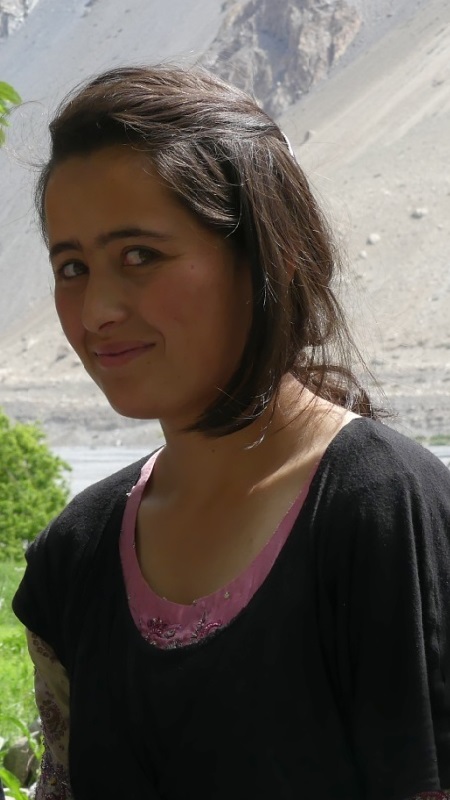
A portrait of a high school Ismaili student who returned to Passu during her school vacation. Photo: © Ali Karim.

Ismaili children in Passu. Photo: © Ali Karim.

A portrait of an Ismaili girl back in Passu during her high-school vacation. Photo: © Ali Karim.
 Passu village — serenity, peace and calmness! Photo: © Ali Karim.
Passu village — serenity, peace and calmness! Photo: © Ali Karim.
The food grown by the villagers is consumed by themselves, and all excess food gets stored in the food stores, and has to last them through the cold winter. The money the men bring in from outside work is used for purchasing what they need that they do not grow themselves, and for other necessities like clothing, medical, school fees and other necessities.

108 year old Mr. Zahoor Muhammed Alvi is the oldest man in Passu! Ali Karim, author of this piece, is pictured wearing a Hunza hat that Mr. Zahoor presented to him as a gift. Photo:© Ali Karim.
This area is well known for long life expectancy, in addition to its breathtaking natural beauty. I asked about this, and we went to visit the oldest person living in Passu, Mr. Zahoor Muhammed Alvi, who was 108yrs old. In this area, everyone knows one another and there are no formalities whatsoever. If you wish to visit someone, you just go to their home, knock and enter their home. We too went uninvited to visit the oldest man in Passu! He sat up in bed to meet us and talked to us in Wahi, the local language. We were served tea/hot milk by his family and chatted for a while. He is not very active now, but he is still healthy enough to move around in the home by himself! I have never met anyone quite that old, so this was a first of its kind for me. Mr. Zahoor gifted me a Hunza hat; it was something I had wanted to purchase anyway, so his special gift will always be remembered by me. We came across the kindest and most giving people here. It was remarkable and heart warming!
 Mr. Zahoor Muhammed Alvi’s 108 year old hands. Photo: © Ali Karim.
Mr. Zahoor Muhammed Alvi’s 108 year old hands. Photo: © Ali Karim.
We visited an Early Chidlhood Development (ECD) center run by the Aga Khan Education Services (AKES) which catered to children from kindergarten to grade 3. They are taught English, Urdu and Wahi, their local language.
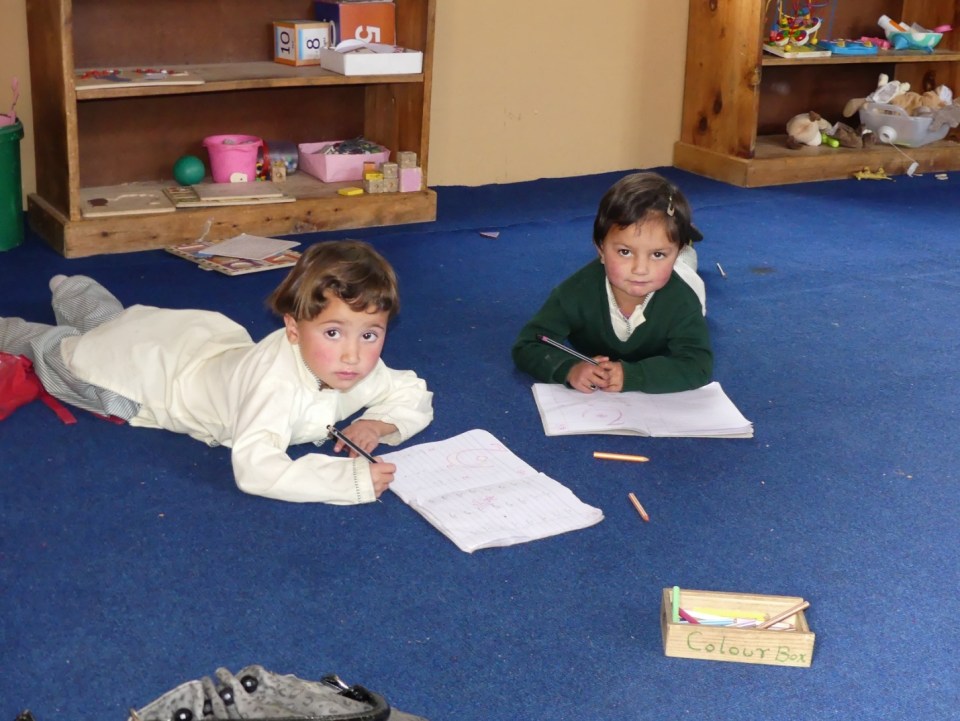 ECD elementary school children. Photo: © Ali Karim.
ECD elementary school children. Photo: © Ali Karim.
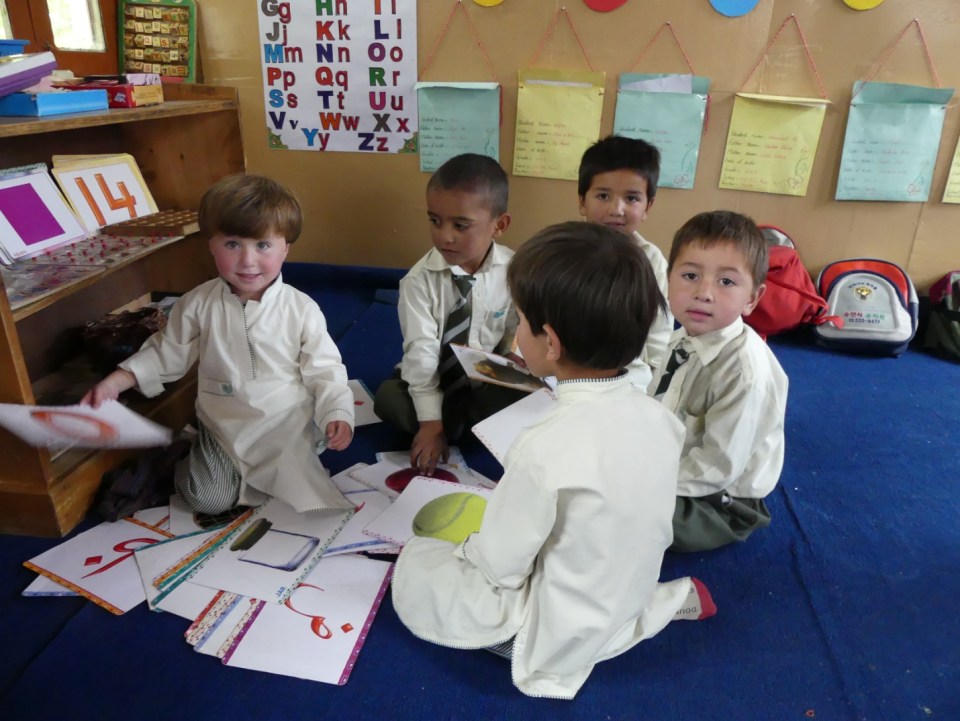 ECD grade 1 children. Photo: © Ali Karim.
ECD grade 1 children. Photo: © Ali Karim.

ECD grade 2 children with their teacher. The children gave a demonstration of how to take care of personal hygiene. The video link of the demo is given at bottom of this piece. Photo: © Ali Karim.

More children in a classroom. Photo: © Ali Karim.
 ECD school compound. Photo: © Ali Karim.
ECD school compound. Photo: © Ali Karim.
Next, we visited the Middle school which was founded by a Japanese lady, that goes from grade 4-8; after which children go for higher grade education to boarding schools in larger towns like Karimabad or Gilgit.
 Middle school in Passu. Photo: © Ali Karim.
Middle school in Passu. Photo: © Ali Karim.
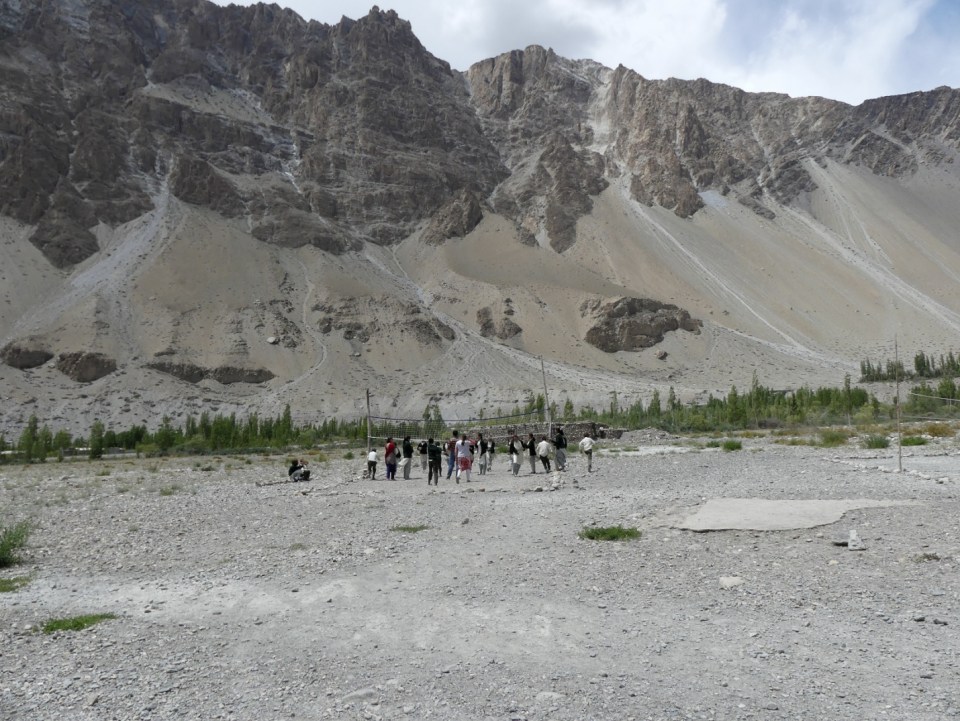 School compounds and recreation areas where students play football (soccer) and volleyball during recess. Photo: © Ali Karim.
School compounds and recreation areas where students play football (soccer) and volleyball during recess. Photo: © Ali Karim.
Tea and Lunch at Ismaili Homes in Passu
We also stopped for tea at Zafar’s house. He lives in a newer part of the village. Many villagers are relocating here as the Hunza river erodes the land of the farms along the river banks. Zafar’s father is 92, and still works in the farm, daily doing manual labor. These are amazingly strong mountain people.
Tea was traditional “choi” (or namak chai). This is tea with a big piece of rock salt in the cup. The more you stir, the more salt you add to the tea.
 Zafar’s 92yr old father, who still works the fields manually every day. Photo: © Ali Karim.
Zafar’s 92yr old father, who still works the fields manually every day. Photo: © Ali Karim.
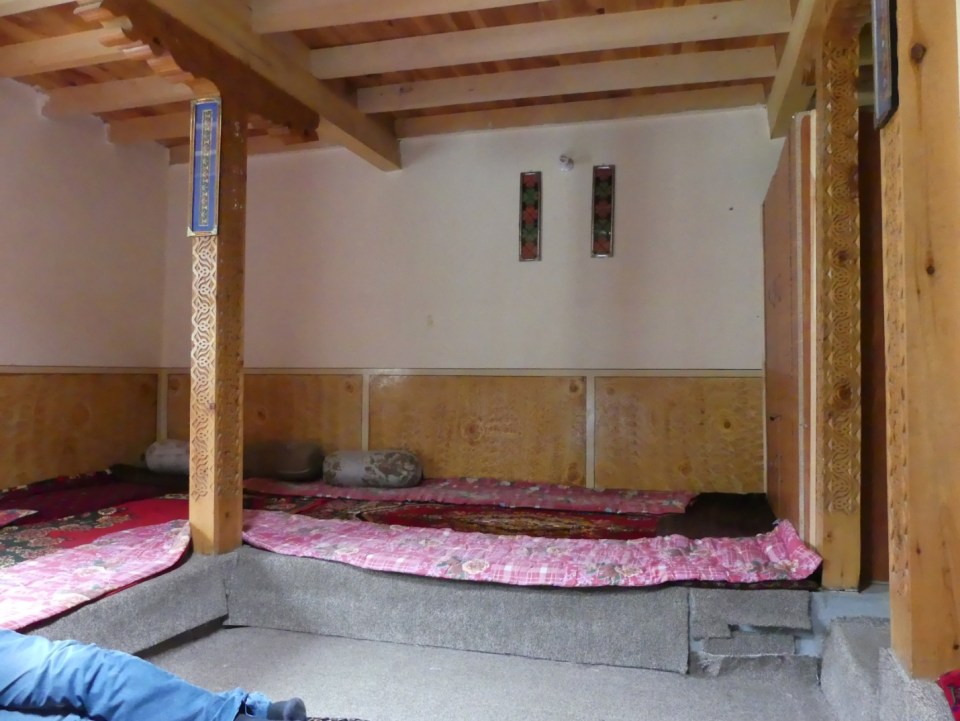 The simple and basic interior of the house. Photo: © Ali Karim.
The simple and basic interior of the house. Photo: © Ali Karim.
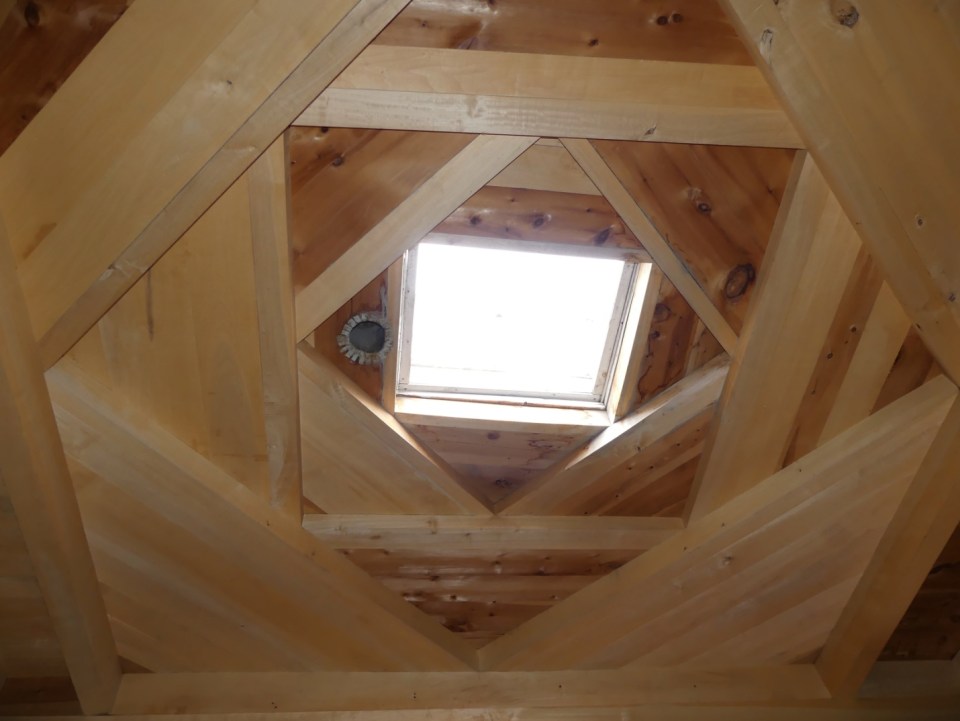 This is a ceiling design which is very much also part of the design in homes in the Gorno-Badakhshan region in Takijistan. There is skylight for light and ventilation, and the round hole on side of the skylight is for the chimney in winter from the stove for heating/cooking. The square in square design is meant to help withstand earthquakes. Photo: © Ali Karim.
This is a ceiling design which is very much also part of the design in homes in the Gorno-Badakhshan region in Takijistan. There is skylight for light and ventilation, and the round hole on side of the skylight is for the chimney in winter from the stove for heating/cooking. The square in square design is meant to help withstand earthquakes. Photo: © Ali Karim.
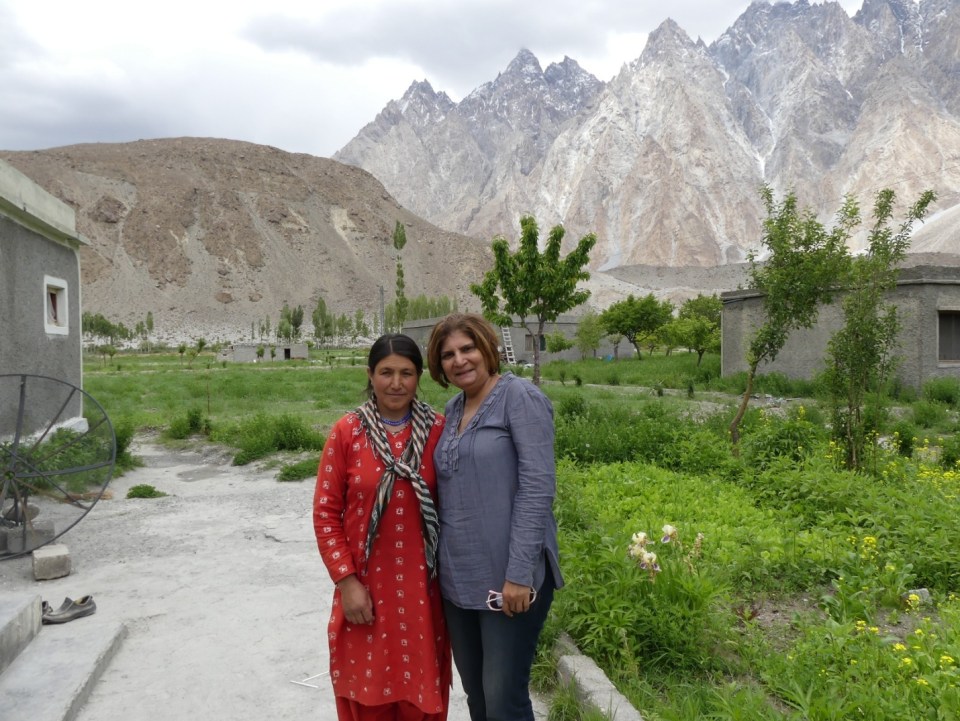 Dilshad (right) with Zafar’s wife outside their home and farm. Photo: © Ali Karim.
Dilshad (right) with Zafar’s wife outside their home and farm. Photo: © Ali Karim.
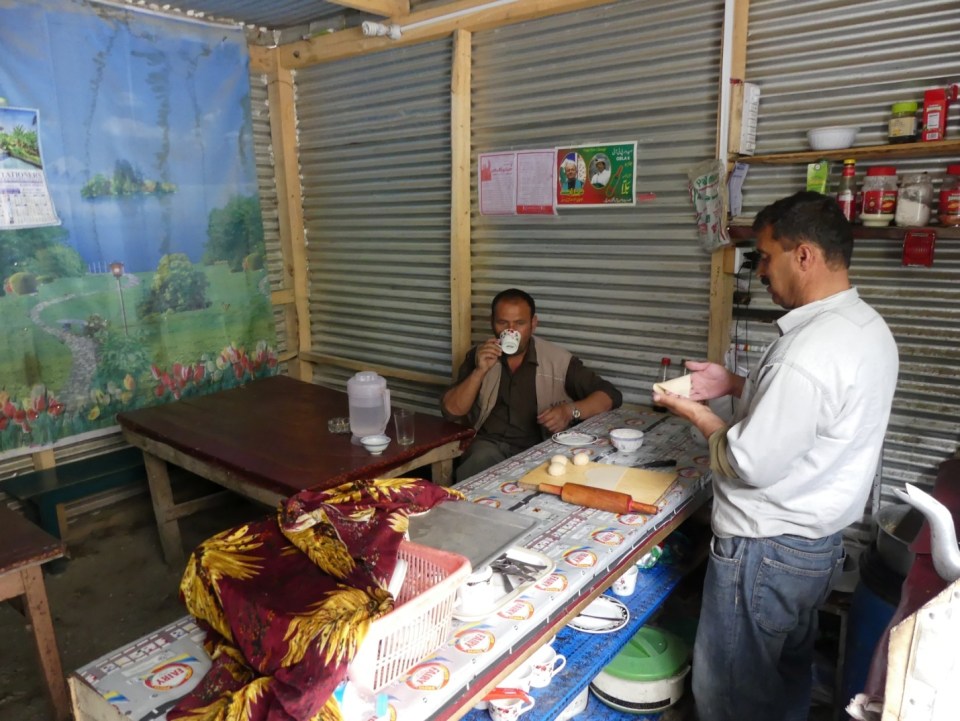 Samosa stop in Passu. Samosas are made mostly with potatoes. Photo: © Ali Karim.
Samosa stop in Passu. Samosas are made mostly with potatoes. Photo: © Ali Karim.
We went for lunch to Abbas’s house. His wife, Joshan, had cooked up a big lunch for us. There were apricot based pancakes, nan, vegetable curry with okra, potato, onion, as well as daal and pilau. What a feast! They grow a lot of potato’s here, and store them for use all winter as a high energy food; which is my kind of food! Abbas’s father is also 92, and also active. Both he and Zafar’s father had fought for Pakistan in the Kashmir war after independence.
 A neat and well organized kitchen! Photo: © Ali Karim.
A neat and well organized kitchen! Photo: © Ali Karim.

Abbas’s wife, Joshun, gets a feast underway in her well-organized kitchen. Photo: © Ali Karim.
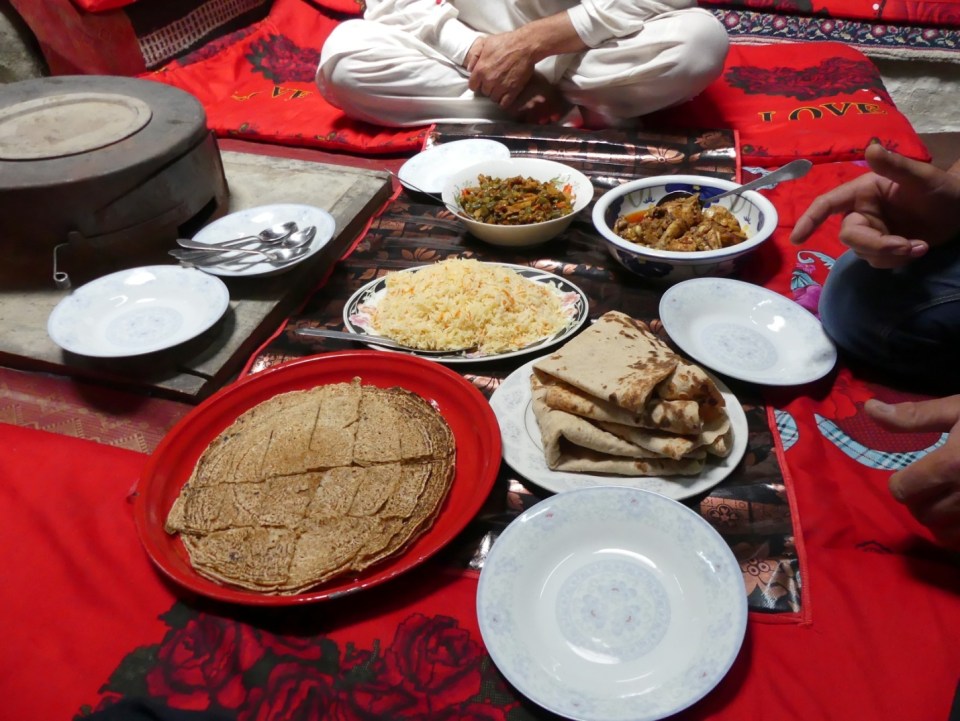
The lunch feast prepared by Joshun — apricot type pancakes, Nan, Rice, vegetable curry and meat curry. Photo: © Ali Karim.
 Abbas and his wife, Joshun, enjoying tea. Photo: © Ali Karim.
Abbas and his wife, Joshun, enjoying tea. Photo: © Ali Karim.
Northern Hunza: Happiness and Fulfillment
Our time in Passu was wonderfully spent with very hospitable people. We were impressed with how hard they worked. Yet they led a simple life, and appeared to be very happy and content. We did not see materialism anywhere. We realized that family is important to them, and they stay close to each other. Also, the ethic of giving is inherent in their nature and we found them to be very welcoming. We could have visited dozens of homes if we had the luxury of more time.
Our stay and experience in Passu was both wonderful and unique as well as humbling. We felt being part of the “One Jamat” or “One Family” that we actually are. Never has this feeling of brotherhood been felt as strongly as we felt it in Passu. The feeling cannot be conveyed in words and this ethic of brotherhood and sisterhood should be emulated everywhere in the Ismaili world, as much as circumstances allow! The balance of the material and spiritual, the dunya and the din, was perfect.
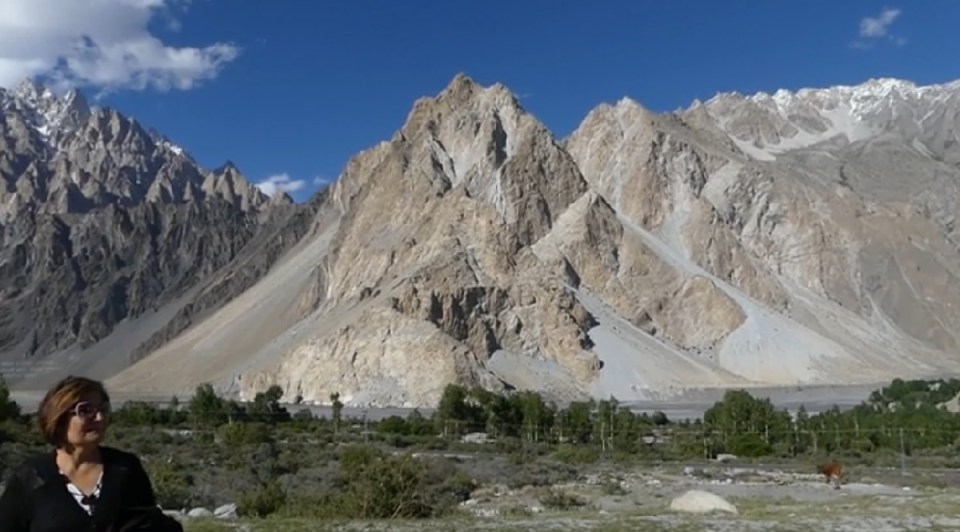 A moment for Dilshad to reflect: “How can we ever forget these majestic mountains and its Ismaili people?” A view of Passu’s scenic surrounding from the Sarai Silk Lodge. Photo: © Ali Karim (from video).
A moment for Dilshad to reflect: “How can we ever forget these majestic mountains and its Ismaili people?” A view of Passu’s scenic surrounding from the Sarai Silk Lodge. Photo: © Ali Karim (from video).
At the end of our time in Khyber village and Passu, we were looking forward to more of the Hunza experience in other towns we would be visiting. The experience was overwhelming, as were the sights! The Ismailis of Khyber village and Passu showed us that you can symbolically scale and even climb above the highest of peaks through goodness, warmth and generosity.
Their adherence to Mawlana Hazar Imam’s guidance has moved them purposefully forward!
Date posted: December 17, 2016.
Last updated: September 4, 2023 (reformatting).
________________
We welcome feedback/letters from our readers. Please use the LEAVE A REPLY box which appears below. Please share this travelogue with your friends!
Links to earlier installments in the Silk Road (China) series and healthy hygiene demo:
- (1) Shanghai, Urumqi and Turpan
- (2) More of Turpan and Historic Kashgar
- (3) More Kashgar and Spectacular Drive to Tashkurgan
- (4) Scenes from Tashkurgan and an Encounter with an Ismaili Family, and the Drive to Northern Hunza on the Iconic Khunjerab Pass
Please click here for a video on personal hygiene demo by Grade 2 students in Passu: https://www.dropbox.com/s/oj7dnix6z1f673f/P1010760.MP4?dl=0
To learn more about Ali and Dilshad Karim’s interest in travelling, please click Contributors.
For a complete list as well as links to fantastic photo essays published on this blog please click on Table of Contents or visit Home Page.
Ya Ali Madad and thank you Ali & Dilshad for highlighting the village life of Hunza.
I am glad you enjoyed the experience of an amazing journey in an amazing part of the world!
Thank you for such a beautiful article.
Sami from Ottawa.
I’m absolutely blown away by the series you have written! I’m a Hunzai Ismaili living in Australia and all the memories are flooding back to me after having read your beautifully written travelogue.
Many thanks to you and Dilshad for taking the time to visit- you absolutely must come again!
Ali, I revisited your travelogue and once again I commend you for a job well done….It gave me the feeling as if I was there with Dilshad and you on this fascinating journey. Zul Walji
Ali Karim: Like other readers I went through your article several times. I not only learnt immensely about this scenic region which I think I may not have chance to visit, but through your panoramic camera lens and your writings, step by step, I felt I have actually visited the region. I was especially very keen to know of this region as my late father used to tell us about how the Ismailis living in these remote areas despite hard conditions of day today life, they never abundant the Faith. Thank you for sharing with us
Shuhkar,
Thank you Ali and Dilshad for such great descriptions and images of our Jamat in these beautiful areas.
As I’ve recently completed my thesis on legislated multiculturalism and second generation hybrid identities (https://www.ruor.uottawa.ca/handle/10393/31833), one of my bucket list goals is to visit these remote areas
and you have sparked that interest very much again. Thank you. We have so much to learn especially when it comes to that balance between din and dunya.
Thanks for your nice pictures.
Truly amazing and breathtaking! Thank you for sharing.
Very nice.
A very good account of the Hunza region.
Breathtaking photographs, beautiful scenery and excellent write-up. Thank you for sharing.
Thanks for posting incredible pictures from my native village Passu and the ECD centre Passu which is supported by Iqra Fund in partnership with the Passu community (CBES) and the AKESP. In 2013, Iqra Fund started supporting the centre, hired and trained four teachers; since then Iqra Fund is supporting the teachers salaries, school supplies and school maintenance related costs. The centre is now a model ECD centre in the area and serving the nearby villages as a learning resource centre. To-date Iqra Fund is supporting 10 ECD centres in Upper Hunza region.
Thanks from Sarai Silk route, Passu for such a nice picture and remarks! You did really great job Ali Karim and Dilshad. We welcome you always.
Warm regards
Alvi Karim
Ali, its all captured so well and makes us feel that we were with you on this trip, you made it all so beautiful the way you have captured all the scenery it has brought tears of joy… Dilshad and you took this beautiful journey together so that we all could also be part of your journey. Thank you Ali for bringing these sacred part of the World to us. Keep up your travels so we too can enjoy, your narration made us feel so much part of your journey.
Ya Ali Madad
I am from Hunza and I must say Ali Karim bhai has captured the soul of Hunza.
With Warm Wishes
Tahira Jabeen
Media, Advocacy & Communication Specialist
Hubert H. Humphrey Fulbright Fellow 2013-2014
UNIVERSITY OF MARYLAND, USA
IVLP-Alumna USA 2012-2013
Tahira, This is indeed a huge compliment for Dilshad & me; I am so glad that I was able to capture the culture, people and their warmth correctly. Thanks for your confirmation.
Beautiful pictures. You both are amazing and you know how to plan your trip Itinerary. Very well written with detailed explanations. We are very proud of you. Enjoy travelling it`s great.
I have always remembered Hunza since Mowlana Hazar Imam’s marriage to Begum Salima in 1969 when the Rani of Hunza threw pearls at his feet. The beauty that I had imagined is confirmed through Ali Karim’s marvellous post and I thank him for sharing the article with readers of Simergphotos.
Beautiful!
Further to my earlier comment, as I read through the post I come across something new. What a sheer joy to learn that our mountainous family has a 100% literacy and over and above their local lingo most of them speak English, the universal language. All these positive outlook of life has been made possible by our beloved Mawlabapa. Thank you Khudavind; we are truly blessed.
Wow Ali, mesmerizing!
Very beautiful!
Ali, Thank you for sharing these fantastic photos. You can make a calendar with those amazing mountains and hills!
We truly enjoyed and shared the article with our kids.
Thank you.
Rajab
Wow! what stunning scenery and thank you again for sharing this with us. What an eye opening knowledge to learn that our global Jamat exists beyond mountains and hills. Truly, as our beloved Mawlabapa has said that no mountains or rivers separate our Hazar Imam’s love for his murids.
Thanks for this good post.
Beautiful!
What an amazing insight into the ‘real’ Hunza. Beyond words…Awesome!
I went through your 5th piece in the Silk Road Travelogue . As before, I truly enjoyed this Hunza post. When I was in Hunza (went only as North just past Karimabad up to the China Border), Hazar Imam was taken to the edge of the border to show the initial stages of the Karakoram Highway (KKH).
Thanks again for sharing.
I am very interested in visiting Hunza but would rather travel via China than Pakistan. Being an American with Ismaili roots I would very much like to visit this beautiful region. Can you please guide me to what travel agency can provide the best tour for my husband and myself?
Hi Issu, Dishad and I have the same background as you, and we travelled to Hunza from China. Please see our blogs on the China part of the trip at:
https://simergphotos.com/2016/10/28/silk-road-travelogue-by-ali-karim-i-shanghai-urumqi-and-turpan/
https://simergphotos.com/2016/11/04/silk-road-travelogue-by-ali-karim-ii-more-of-turpan-and-historic-kashgar/
https://simergphotos.com/2016/11/14/silk-road-travelogue-by-ali-karim-iii-more-kashgar-and-spectacular-drive-to-tashkurgan/
https://simergphotos.com/2016/11/24/silk-road-travelogue-by-ali-karim-4-scenes-from-tashkurgan-and-an-encounter-with-an-ismaili-family-and-the-drive-to-northern-hunza-on-the-iconic-khunjerab-pass/
https://simergphotos.com/2016/12/17/silk-road-travelogue-by-ali-karim-5-ismailis-of-remote-northern-hunza-rise-high-above-the-tallest-peaks-and-set-a-lasting-example-for-us-to-follow/
PLease contact me through this Simerg site (via the editor – Malik Merchant at simerg@aol.com) and I can provide you more details on tour operators etc,
Dear Malik,
Ya Ali Madad, Thank you very much for sharing Ali Karim’s excellent travelogue of our area. I am an Ismaili from Hunza, Pakistan. If anyone needs further details about Silk Route destinations, Hunza Valley, Ghizer & Chitral, please do let me know!!!
Ya Ali Madad Ali
Thank you very much to for sharing these amazing (khuda ki kudraat – God’s Nature) photos on Simergphotos. You are indeed both blessed and may God continue showering His blessing on both of you.
Thank you
Nedtess Family
Ali, Absolutely stunning images; can’t wait to go there.
Merci & Cheers
Muslim Harji
Amazing pictures. So beautiful! 🙂
Pingback: Silk Road Travelogue by Ali Karim: (5) Ismailis of Remote Northern Hunza Rise High Above the Tallest Peaks, and Set a Lasting Example for Us to Follow | gulzara
Amazing and thanks for these very beautiful photos.
Beautiful and thanks for sharing your experience with us. Good thing only deserving people have the power to reach such places! Let us not disturb their authentic reality of peace and grandeur with our own inimitable Khoja brand of peace and grandeur. Obviously they are qualified to teach many of us by their example. I hope Simerg will talk more about their history, their pirs and mentors!
Nice!
Wow – breathtaking!
Just beautiful!
These photos are momentous! What a jamat we have in Northern Hunza, and the scenery is extraordinary and out of this world. Certainly, a must visit destination!
Thank you for sharing these excellent photographs!
Stunning!
Very pretty scenery.
Ali Karim’s Hunza story and pictures are awesome and inspiring. Keep up the great work. I am proud of being an Ismaili.